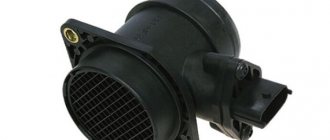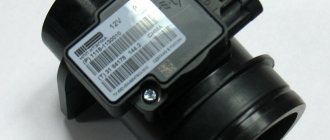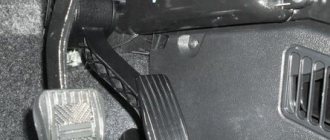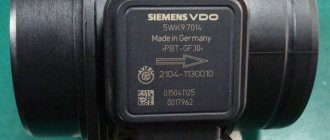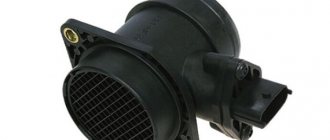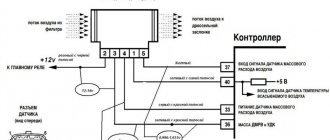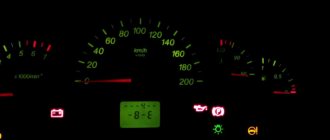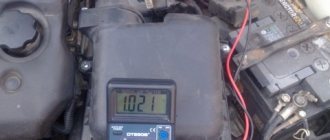In the electronic engine control system of the popular Russian small car Lada Kalina, the sensor responsible for the mass flow of intake air (mass air flow sensor) is a very important component. It is located close to the air filter. Its purpose is to determine the mass fraction of air flow supplied to the combustion chambers of the engine.
If incorrect operation of the mass air flow sensor is observed, this creates the preconditions for malfunctions in the functionality of the engine. Diagnostics will help identify the problem. If a breakdown occurs, the owner will need to replace the specified sensor.
It is no secret that any component of the Lada Kalina car needs a periodic review of its condition. Prevention allows you to timely identify a malfunction and take prompt measures to eliminate it. Next, we will tell you how to check the mass air flow sensor.
MAF Lada Kalina
The internal combustion engine does not run on gasoline or diesel fuel, despite the obviousness of the statement.
To perform the work of the piston, a fuel-air mixture is required, in which the liquid fraction and air are mixed in a certain proportion. Maximum energy release occurs at a ratio of 1 kg of gasoline to 15 (more precisely 14.7) kg of air saturated with oxygen. Modern LADA Kalina engines (no matter 1st or 2nd generation) are controlled by an ECU, which sets this very proportion. It commands the injectors to deliver an exact portion of gasoline into the combustion chamber. But how does the electronic “brain” know how much air will get into this very chamber? The air flow is controlled by the throttle valve. When we press the gas pedal, we don’t think that air is supplied first, and then gasoline in the right proportion. The ECU must receive information about how much air is entering the intake manifold. The mass air flow sensor, abbreviated as MAF, is designed to measure it. The illustration shows a LADA Kalina 1118 flow meter.
In any version of the engine, it is installed in front of the intake manifold immediately after the air filter.
Basic faults
The mass air flow sensor rarely fails, but if this happens, it will not be difficult to determine the malfunction. To do this, know the main signs with which you can check the condition:
- Excessive consumption of fuel. We learn about this from the on-board computer indicators. If a malfunction occurs, consumption may increase by 1 liter or more.
- Decrease in dynamics. The engine does not produce the power that yesterday was not a difficult task for the VAZ 2110.
- Interruptions in the operation of the power plant. Slow acceleration or too fast.
- The engine does not start or does not start the first time.
- Floating speed. This concept means that a spontaneous increase or decrease in speed occurs.
How to choose a new MAF sensor (Kalina 8 valves)
In order to ensure maximum system performance and compatibility with the controller, before replacing an old product with a new one, you must carefully read the markings on the product body. When purchasing new products, beware of counterfeits!
Some recommendations on what you should pay attention to (regarding BOSCH products): - inside the connector of the original sensor, next to the contacts, there are three metal wells that resemble the heads of small nails in appearance. These elements are used at the Bosch plant to program the sensitivity of the mass air flow sensor. On counterfeit products, such elements are absent or have a plastic structure.
Signs of a faulty air air sensor on Lada Kalina and Granta: how to check and clean the air sensor
When the internal combustion engines that modern cars are equipped with operate, a fuel-air mixture is burned, for the formation of which, as you can easily guess from its very name, it is necessary to mix fuel with air, and in strictly defined proportions.
Accordingly, the systems that are responsible for the formation of this substance must accurately “know” the consumption of each of its components at every moment of operation of the power unit. The value of this indicator for one of them helps to determine the mass air flow sensor (MAF).
It should be noted that it is present in the design of only injection engines, and if drivers notice signs of a malfunction of the mass air flow sensor, then it should be checked and, if necessary, replaced.
Why do you need a mass air flow sensor?
What does a mass air flow sensor look like on a car?
The mass air flow sensor is an important sensor located directly behind the engine air filter, or more precisely, just between it and the throttle assembly. It is designed so finely that it allows you to accurately measure the flow rate of only air that is well cleared of mechanical impurities
During operation, the mass air flow sensor transmits signals to the electronic engine control system, which are processed and interpreted as the volume of air that is supplied to form the fuel-air mixture. For normal operation of the power unit, the volumetric ratio of liquid fuel (gasoline, diesel fuel) and air in it should be close to 1x14. If this proportion is violated, then either a significant loss of engine power or excessive fuel consumption occurs (these, by the way, are the main signs of a malfunction of the mass air flow sensor). The information received by the ECU from the sensor that determines the mass air flow helps to avoid this.
The mass air flow sensor measures the amount of air that enters the fuel rail per unit time. It transmits this data to the ECU, which instantly calculates the amount of liquid fuel that needs to be supplied to form the mixture, and gives the appropriate “instructions” to the engine devices responsible for this. Thus, if, for example, you press the accelerator pedal, more air immediately begins to flow, the mass air flow sensor instantly detects this, sends data to the computer, which increases the supply of gasoline or diesel fuel in the appropriate proportion. If the amount of air decreases, then the volume of liquid fuel supply decreases.
From a design point of view, there are three types of such sensors that are actively used:
- Based on pitot tube;
- With hot-wire anemometers;
- With film meters.
Mass air flow sensors built on the basis of a pitot tube are considered obsolete and are not used in the newest engine models. They are so-called vane flowmeters, the main elements of which are plates connected to potentiometers and softly fixed to the axes. Changing their position under the influence of air flow, they act on the potentiometer, which changes its electrical resistance.
Mass air flow sensors with hot-wire type meters are quite expensive, although they are very effective. They are equipped with special heat exchangers consisting of two platinum filaments, which are heated by passing electric current.
One of them is blown with a flow of air, the second remains a control one, and based on the difference in the current passing through them, the ECU calculates the amount of air supplied to form the fuel mixture. Mass air flow sensors with film meters are considered the most modern.
According to their principle of operation, they are almost similar to hot-wire anemometers, only they do not use platinum threads, but ceramic elements coated with platinum.
Main symptoms of a malfunctioning mass air flow sensor
A malfunction of the mass air flow sensor, as noted above, leads to either an over-enrichment or a depletion of the fuel mixture with gasoline or diesel fuel, which negatively affects the functioning of the engine and can lead to serious damage. Most often, malfunctions of the mass air flow sensor are associated with a clogged air filter: the air is poorly cleaned, and the mechanical particles contained in it get into the sensor, which is the cause of its failure. It should be noted that mass air flow sensors are non-repairable devices, and if they fail, they must be replaced with new ones.
Practice shows that the main signs of a malfunction of the mass air flow sensor are as follows:
- A Check Engine error appears, which indicates that the signal level of this sensor is very low;
- The engine consumes more fuel than usual;
- The power unit does not start well, its power decreases, it begins to stall;
- The car accelerates poorly;
- The engine runs either at high or low speed.
Of course, all the signs may also appear during other vehicle malfunctions, but in any case, if at least one of them is detected, this is a good reason to visit a service station. However, you can check the mass air flow sensor for malfunctions yourself, without contacting service station specialists.
Flowmeter design
Knowing the design of the air sensor, you will quickly understand the principle of its operation and understand why a faulty meter cannot be repaired, but only replaced. The device is not difficult to find - it is built into the air duct connecting the filter - air flow purifier with the throttle valve block. The exact location depends on the make and model of the car.
The majority of vehicles in use are equipped with hot-wire or film meters. The difference is in the design of the sensing element; the operating principle remains unchanged. An anemometer flow meter is a housing in which 2 platinum threads are placed - a measuring and a reference. How does the mass air flow sensor function in a car:
- The controller supplies power to both threads. As they heat up, they change resistance equally.
- When the engine is running, the first thread is washed by air passing through the throttle and cooled. The stronger the air flow, the more intense the cooling.
- The electronic unit records the difference in resistance between the measuring and reference threads. Having made the calculation, the ECU determines the mass of passing air and directs the corresponding amount of fuel to the injectors.
Reference. In modern cars with turbocharged engines, mass flow sensors are replaced by absolute pressure meters (MAP) - more reliable devices with a long service life. Manufacturers began to equip new naturally aspirated engines with similar products.
The film measuring device operates on the same principle, only instead of threads, platinum-coated ceramic elements are used. That is why it is quite possible to check the mass air flow sensor, but not to repair it. A burnt thread or damaged coating cannot be replaced, only the entire product.
Connector to the mass air flow sensor (MAF) on Kalina E-GAS
Dear customers, in order to avoid errors when sending the connecting connector to the mass air flow sensor (MAF), in the “Comment” line indicate which mass air flow sensor, your car model, year of manufacture and number of valves, engine size.
In different versions of fuel injection systems on VAZ vehicles, two types of mass air flow sensors (MAF) can be used. They differ in design and in the nature of the output signal, which can be frequency or analog. In the first case, the signal frequency changes depending on the air flow, and in the second case, the voltage changes. The ECU uses information from the mass air flow sensor to determine the duration of the injector opening pulse.
The VAZ 1118 mass air flow sensor (E-GAS) of hot-wire type is installed in a housing located between the air filter and the air supply hose to the throttle assembly. The controller uses information from the mass air flow sensor to determine the duration of the injector opening pulse. The sensor uses three sensing elements. One element determines the air temperature, and the other two, connected in parallel, are heated to a certain temperature higher than the air temperature.
The air passing through the sensor cools the heated elements. The higher the air flow rate, the more intense the cooling. The sensor's electronic circuit determines air flow by measuring the electrical power required to maintain a given temperature of the heated elements. The sensor provides information about air flow in the form of a digital signal.
Connecting block 1118-1130010АХ with 10 contacts assembled with wires, is one of the elements of the controller harness, connects to the VAZ 1118 mass air flow sensor (E-GAS) in Lada Kalina, Lada Priora, Lada Samara 2, Lada Granta cars and their modifications injector (8V) with engine capacity 1.6L, (E-GAS), EURO-4. Can be used to make your own cable. The contacts are already crimped onto the wires (wire length 100 mm) and inserted into the connector according to the pinout, so they can be installed on the car.
Structurally Mass air flow sensor (MAF) VAZ 1118 (E-GAS) Art. 1118-1130010 has a sensing element, a thin mesh (membrane) based on silicon, which is installed in the intake air flow. The grid contains a heating resistor and two temperature sensors, which are installed before and after the heating resistor.
If the sensor or its circuits fail, the engine management system malfunction indicator in the instrument cluster lights up, and the controller calculates the mass air flow value based on the crankshaft speed and throttle position.
The accelerator pedal position is transmitted to the engine control unit via two accelerator pedal position sensors (variable resistors), which are connected to the accelerator pedal.
The position of the VAZ 1117-1119 accelerator pedal (depending on the driver’s actions) is the main input value for the engine control unit.
The throttle valve is driven by an electric motor (throttle servomotor) in the throttle valve control module, namely over the entire speed and load range.
The VAZ 21116 throttle valve is actuated by a servo drive according to signals from the engine control unit. With the engine off and the ignition on, the engine control unit controls the throttle servomotor, exactly matching the data from the accelerator pedal position sensor. This means that when the accelerator pedal of the VAZ 1117-1119 is pressed halfway, the servo drive equally opens the throttle valve; in this case, the throttle valve will also be open approximately halfway.
When the engine is running (under load), the engine control unit can open and close the throttle valve, independent of the accelerator pedal position sensor.
So, for example, the throttle valve of a VAZ 21116 may already be fully open, although the accelerator pedal of a VAZ 1117-1119 is only pressed halfway.
The advantage of this scheme is that throttling losses at the throttle valve are prevented.
In addition, at certain loads there are noticeably better emissions and fuel consumption figures.
Replacement of contact carrier 1118-1130010АХ assembled with wires, which is an element of the ignition system harness, connecting the VAZ 1118 mass air flow sensor (E-GAS) in cars Lada Kalina, Lada Priora, Lada Samara 2, Lada Granta and their modifications injector (8V) with engine capacity 1.6L, (E-GAS), EURO-4, can be done independently, without contacting specialized maintenance services.
The engine control unit, analyzing the required torque for various components (e.g. air conditioning, automatic transmission, ABS/ESP..), calculates the optimal throttle opening angle for a given situation.
Product Features:
The mass air flow sensor (designation according to the catalog of NPP "ITELMA" 1118-1130010) is designed to convert the air flow entering the engine into DC voltage. The sensor information allows you to determine the engine operating mode and calculate the cyclic filling of the cylinders with air at steady engine operating conditions, the duration of which exceeds 0.1 seconds.
Based on the sensor signal, the ECU calculates the amount of air entering the engine cylinders. If the mass air flow sensor malfunctions, the electronic control unit switches the system to backup mode.
Where is the DMRV located?
The sensor is located between the air filter and the air supply hose (pictured No. 13).
Catalog numbers of mass air flow sensor on LADA cars:
- Lada Priora, Kalina and Niva 4x4 – 21083-1130010-20.
- Lada Granta and Kalina 2 – 11180-1130010-00.
- Lada Vesta, Largus and XRAY - no mass air flow sensor. Modern VAZ engines (21127, 21129, 21179) and Renault engines (K7M and K4M) do not have a mass air flow sensor; instead, an absolute pressure sensor (APS) and an air temperature sensor (ATS) are installed.
What mass air flow sensors are installed on LADA Kalina cars
In two generations, these cars were equipped with engines of 1.4 and 1.6 liters with 8 and 16 valve cylinder heads. Of course, there is no point in selecting a personal mass air flow sensor for each Kalina model, so there are only 4 options. To find out which sensor is in your Kalina, you need to read the ECU version in the passport (it can be “BOSCH MP” or “January”). The correspondence table is shown in the illustration.
So, we see varieties of flow meters with indexes 004, 037, 116 and 010. Structurally they are identical, the only difference is in the ECU firmware for each specific sensor. The engine control program contains calibration of the correspondence of the voltage at the signal output of the flow meter to the air mass in kg.
Is it possible to replace an old mass air flow sensor with a new one of a later version? No, the ECU will not work correctly. You can change the firmware, but this will not benefit the engine. Moreover, all versions of the sensors are on sale both from BOSCH and domestic analogues.
How to independently check the mass air flow sensor for serviceability
- Diagnostic scanner and OBD-II error code detection program. A method that guarantees 100% results, but requires basic user training.
- Check the connector of the connecting cable from the ECU for the integrity of the wires and contacts. Performed with the engine turned off and the ignition key in “ON” position. The connector is first disconnected from the flow meter. It is necessary to make sure that there is a supply of 12 V on contact No. 2, and 5 V on contact No. 4 relative to the negative contact No. 3 (ground).
- Checking the functionality of electronic sensors and the control board of the Kalina mass air flow sensor. The connector is connected, the engine is turned off, the key is in the “ON” position. The quiescent voltage of a working flow meter on pin No. 5 should correspond to 1 V (± 0.02 V). If the multimeter shows a voltage of 1.03–1.05 V, the mass air flow sensor needs to be replaced quickly, but can still work. A faulty flow meter will show a voltage of more than 1.05 V.
The driver will immediately feel the symptoms of the malfunction. Traction disappears at the slightest load, the car stalls when going uphill. When the engine is not warmed up, the speed fluctuates and hangs after releasing the gas. The “Check-Engine” indicator light comes on and does not go out.
Tip: To prevent breakdowns of an expensive flow meter, it is recommended to check its condition by inspection each time the air filter is replaced. If dust or moisture is found inside, you need to find and eliminate the cause, and blow the sensor itself with compressed air or wash it with a special aerosol product.
Causes of problems
The air flow meter becomes unusable for the following reasons:
- a lot of dust and dirt gets on the measuring elements, because the car owner rarely changes the air filter;
- on heavily worn engines, gasoline and oil vapors penetrate into the mass air flow sensor through the crankcase ventilation pipe;
- a hole in the corrugated air duct from where dust is sucked in;
- accidental damage due to unqualified repairs;
- break in the wires connecting the sensor connector to the controller.
Checking the mass air flow sensor circuit
First of all, you should check the wiring leading to the sensor. To do this, use a voltmeter to measure the voltage at the terminals of the 5-pin block, having previously disconnected it. Measurements are taken with the ignition on and the engine off. If the sensor’s power supply circuit is working properly, then the voltage between 2 and 3 sensor terminals should be at least 10 V, and between 3 and 4, 1 and 3 – 4.8–5.2 V.
If a multimeter is used as a diagnostic device, it is also necessary to measure the resistance between pin 5 and ground. The normal resistance level is 4–6 kOhm. If it is below this level, there is a short to ground. If the measurement result exceeds 100 kOhm, this indicates an open circuit or a controller malfunction.
Reasons for error P0113
In diagnostic devices, this “trouble” is called Intake Air Temperature Sensor High. The described error p0113 appears in only four cases, which is due to the simplicity of the sensor design:
- malfunction of the thermistor itself;
- a violation in the sensor’s power supply circuit—one of the wires is shorted or broken;
- there is no electrical contact in the connecting block;
- a layer of dirt and (or) oil stains settling on the sensor, reducing the sensitivity of the thermistor.
The “error 113” indication can appear on any modern car, both Russian and foreign made. It could be Mercedes with Audi or VAZ 2112, 2114, GAZ, UAZ.
An intake air temperature sensor is installed on any modern engine. Sometimes the reason is quite banal. Error 0113 on a VAZ 2114 or VAZ 2115, 2110, 2111, 2107-2109 (injector) sometimes appears after the car has been parked for a long time without use, when the battery is too, but not completely, discharged. Charging it restores the functionality of the machine's systems, including the air temperature sensor.
“Features of replacing the regulator on Kalinas and Grants”
A specialist will tell you what needs to be taken into account when replacing the regulator in domestic cars and what mistakes should not be made (the author of the video is the channel In Sandro’s Garage).
In the electronic engine control system of the popular Russian small car Lada Kalina, the sensor responsible for the mass flow of intake air (mass air flow sensor) is a very important component. It is located close to the air filter. Its purpose is to determine the mass fraction of air flow supplied to the combustion chambers of the engine.
If incorrect operation of the mass air flow sensor is observed, this creates the preconditions for malfunctions in the functionality of the engine. Diagnostics will help identify the problem. If a breakdown occurs, the owner will need to replace the specified sensor.
It is no secret that any component of the Lada Kalina car needs a periodic review of its condition. Prevention allows you to timely identify a malfunction and take prompt measures to eliminate it. Next, we will tell you how to check the mass air flow sensor.
Checking the regulator for functionality
There are several options for checking the functionality of the sensor.
First, let's look at the simplest of them:
- You need to disconnect the power connector from the controller.
- Start the engine.
- Try going for a little drive. If you notice that the engine has begun to operate more normally and the symptoms described above have disappeared, this indicates that the mass air flow sensor you removed is inoperative. Please note that when the controller is turned off, the control unit begins to operate in emergency mode, accordingly, fuel consumption can be increased (the author of the video about the demonstration of the failed regulator is the channel In Sandro's Garage).
To implement another method, you will need a tester - a multimeter, as well as a screwdriver and a 10mm wrench.
The diagnostic procedure using a multimeter is as follows:
- First you need to turn on the tester, set it to DC voltage measurement mode, and note the limit of 2 volts. On the power cable connection plug you need to find wires of yellow and green colors, this will be the output and ground, please note that the color may vary. The yellow wire is the closest one, it is closer to the windshield, and the green one is the third in a row, if you count from the same edge. Even if their color is different, the location should be the same.
- You need to measure the voltage between these contacts, while the ignition should be activated, but you do not need to start the engine. The tester probes must be installed through rubberized seals along the wires themselves, being careful not to damage the insulation. You can spray the probes with WD-40 in advance.
- After completing these steps, you need to evaluate the results. If the DMRAV is working properly, then the voltage reading will vary around 0.996-1.01 volts. If the voltage level is higher, this indicates a failure or deterioration in the technical condition of the flow meter. In practice, it is necessary to plan to replace the device if the resulting voltage is higher than 1.04 volts.
LENTA troubleshooting
There are several options for troubleshooting device problems:
- Replacement Most. sensor is a sure way to ensure normal system operation by installing a known working controller.
- Check the connection of the regulator, as well as its functionality. Very. electrical circuits are rare, but it happens that the regulator refuses to work normally due to oxidation of the connector on the contacts. In this case, you can try to disconnect the sensor and clean the iron contacts.
- wash the device with a brush. This recovery option is today considered one of the most popular among our compatriots. Cleaning usually takes a little time, but you have a chance to restore the regulator to working order. Our resource has already written about flushing the device; detailed step-by-step instructions are presented in this article.
Diagnostics of mass air flow sensor on Kalina
If checking the circuit does not reveal any damage, you can proceed directly to diagnosing the mass air flow sensor. The most objective way is to measure the voltage between 3 (middle) and 5 (closest to the windshield) sensor terminals. The wire block is not removed - the probes must be brought to the contacts through it - rubber seals allow this to be done. The engine must be turned off and the ignition on.
For a new mass air flow sensor, the measurement results are 0.99–1.01 V. Values in the range of 1.01–1.03 V are quite acceptable for sensors that have worked for some time; a voltage of 1.03–1.04 indicates that the mass air flow sensor is about to fail and is operating at the limit of its capabilities. If the voltage is above 1.04, the sensor needs maintenance or replacement and is 99% the source of the problems noticed.
If you don’t have a voltmeter at hand, you can first check the mass air flow sensor using traditional methods. If you notice a deterioration in throttle response, you can remove the connector from the sensor and try driving without it. If acceleration dynamics improve, the sensor or its circuit is faulty. The second method is with the engine running in neutral gear, increase the speed to 2000 per minute and sharply press the gas pedal. Is the turnover growing slowly? Most likely, the mass air flow sensor will need to be replaced.
There are several ways to check the mass air flow sensor on Kalina. The simplest of them is to temporarily disable the sensors and study the car’s reaction to its “absence”. For a more detailed and objective diagnosis of the sensor itself and its power supply circuit, it is better to use a multimeter. The main conclusions can be drawn from the voltage at terminals 3 and 5 of the sensor when the ignition is on.
The MAF (mass air flow sensor) is designed to estimate the amount of air entering the engine of a fuel injected vehicle. Based on its data, the electronic control unit (ECU) adjusts the composition of the fuel-air mixture. Let's look at the features of checking the mass air flow sensor with a multimeter.
Diagnostics in garage conditions
The above symptoms also appear during other failures, for example, failure of the oxygen sensor or throttle position. In all such cases, the electronic unit operates in the same way - it goes into emergency mode for preparing the air-gasoline mixture. Hence similar consequences.
To test the mass air flow sensor without instruments, follow these simple steps:
- Open the hood and disconnect the connector from the mass air flow sensor.
- Start the engine and monitor idle speed. The controller must raise the crankshaft speed to 1500 rpm and hold it stably. If the idle speed continues to float, the flow meter is most likely working.
- Make a test drive over a short distance, observing the behavior of the car. If the engine starts to work even worse, then the problem lies elsewhere.
This technique does not allow one to accurately determine the “culprit” of problems, especially when there are several of them. For example, at the same time the lambda probe failed. It is necessary to carry out more accurate diagnostics - check the mass air flow sensor with a multimeter according to the following instructions:
- Switch the multimeter to voltage measurement mode. Open the hood and find the sensor connection block.
- Connect the red wire from the device to the input signal contact (usually colored yellow). Connect the second clamp with black insulation to the green conductor.
- Turn on the ignition and record the voltmeter readings.
A voltage in the range of 1–1.03 V indicates full functionality of the sensor. If you observe signs of emergency mode while driving a car, it is worth checking other meters that affect fuel supply.
Readings of 1.04–1.05 volts indicate that the platinum elements of the sensor are quite worn out, and you should prepare to replace the mass air flow sensor. A value of 1.06 V or more indicates that the air flow meter has died. You need to purchase a new meter and install it on the air duct instead of the old one.
If, as a result of the diagnosis, you received average readings, it would not hurt to clean the sensor. Do not try to get inside the mass air flow sensor with various brushes - for this purpose there is a special liquid on sale that washes away dirt from the air mesh and measuring elements.
View Queue
Queue
- delete everything
- Disable
How to check the mass air flow sensor on a Lada Kalina
In the electronic engine control system of the popular Russian small car Lada Kalina, the sensor responsible for the mass flow of intake air (mass air flow sensor) is a very important component. It is located close to the air filter. Its purpose is to determine the mass fraction of air flow supplied to the combustion chambers of the engine. If incorrect operation of the mass air flow sensor is observed, this creates the preconditions for malfunctions in the functionality of the engine. Diagnostics will help identify the problem. If a breakdown occurs, the owner will need to replace the specified sensor.
It is no secret that any component of the Lada Kalina car needs a periodic review of its condition. Prevention allows you to timely identify a malfunction and take prompt measures to eliminate it. Next, we will tell you how to check the mass air flow sensor.
Signs of sensor failure
Regarding the mass flow sensor, we note that in order to identify incorrect operation or breakdown, the owner should familiarize himself with the main signs of failure.
These include the following points:
- reduction in the level of power produced by the motor;
- deterioration of the vehicle's dynamic capabilities;
- When the engine is warm, it becomes difficult to start;
- fuel consumption has increased;
- The dashboard was “illuminated” by the glowing “Check Engine” lamp.
If one of the indicated symptoms appears, the first step is to check the mass air flow sensor in the Lada Kalina car.
How do they check the sensor in Kalina?
How to check the DMRV? It is possible to perform diagnostics manually in a regular garage.
The following methods will come to the rescue here.
- Turn off the air sensor and start the engine. In this case, the ECU switches to operating according to the emergency program. The air-fuel mixture is prepared only in accordance with the position of the valve in the throttle assembly. We start moving and feel a change in dynamics in a positive direction. Verdict - replace the sensor!
- Alternative firmware version of the on-board engine control module. It is possible that the firmware was previously replaced and the owner of the Lada Kalina does not know what exactly is “hardwired” in it in case of activation of the emergency engine operation program (with the mass air flow sensor disabled). In this option, we place a plate 1 mm thick under the damper stop. The revs will naturally rise. At this moment we remove the “chip” from the connector on the sensor. If the motor stops, then the firmware itself is to blame, or rather, the steps of the XX regulator for emergency mode.
- We measure the voltage at the terminals of the connected mass air flow sensor. We set the multimeter to a range with a limit of 2 Volts. Turn on the ignition and take measurements. The absence of a malfunction will be confirmed by a voltage value of 1.01-1.02 V.
- We inspect visually. Using a screwdriver, remove the clamp and corrugated pipe of the air supply system to the manifold. We remove the sensor itself and look at its external condition. There are no traces of moisture or scratches. If the air sensor is covered with a film of oil, then we suspect the engine for wear of its elements or the crankcase ventilation system.
Replacing the mass air flow sensor in the Kalina model
When the owner of a Lada Kalina feels a deterioration in engine performance along with the presence of the above symptoms, or a malfunction of the mass air flow sensor is identified during a thorough diagnosis, it is not recommended to delay the procedure for replacing the component. If repairs are neglected, the problem will begin to progress, causing the LADA Kalina engine to “lose” its full functionality. The replacement process itself is very simple and does not require detailed comments. It is recommended to observe safety measures regarding preliminary de-energization of the on-board network by disconnecting the terminals from the battery.
Let's sum it up
The mass air flow sensor in the LADA Kalina car is a fairly “tenacious” component of the engine control system. The air sensor does not require any additional measures regarding its maintenance. The owner is recommended to lean towards routine periodic diagnostics of all systems and not to neglect the timely replacement of the air filter, especially since now you know how to check the mass air flow sensor.
Checking the mass air flow sensor with a multimeter
1. Check the voltage on the mass air flow sensor block:
- Set the multimeter to voltmeter mode.
- Remove the connector with the wires from the mass air flow sensor (snap off the lock).
- Turn on the ignition.
- We connect the negative probe of the device to the engine ground, and the other to terminal No. 2 of the block (there is a number on the block).
- We measure the voltage at terminal No. 4 of the block.
The voltage at pin No. 2 should be at least 12 V, and at pin No. 4 about 5 V. If the device readings are different, it means the battery is discharged, the power circuit or the computer is faulty.
2. We check the Bosch mass air flow sensor on Lada Priora and Kalina 1 (with article numbers: 0 280 218 004, 0 280 218 037, 0 280 218 116):
- Set the multimeter to voltmeter mode. (measurement limit 2 V).
- Turn on the ignition.
- We connect the “negative” probe of the device to terminal No. 3, and the other to terminal No. 1.
Compare the device readings with the table:
| Voltage, V | Air flow sensor condition |
| 0.996. 1.01 V | Voltage of the new mass air flow sensor |
| 1.01. 1.02 | Good condition of the sensor |
| 1.02. 1.03 | Normal sensor condition |
| 1.03. 1.04 | Sensor life is coming to an end |
| 1.04. 1.05 | “Near-death” state, if there are no negative symptoms, then we continue to exploit |
| 1.05. and higher | It's time to replace the sensor |
Another way to check the mass air flow sensor is to replace it with a known good one.
Have you encountered a malfunction of the mass air flow sensor? If the mass air flow sensor turns out to be in good condition, and there are problems with the engine, read “Why the engine shakes, jerks, or pulls poorly” and “Why the speed fluctuates.”
Consequences of sensor failure
When, for various reasons, the sensor fails or produces incorrect readings, the controller changes the operating algorithm. He begins to prepare the air-fuel mixture, focusing on the throttle position meter and lambda probe. Due to the lack of data previously received from the mass air flow sensor, the electronic unit “does not know” about the real amount of incoming air and cannot mix it with gasoline in optimal proportions.
By switching the controller to emergency operation mode, you can determine the main symptoms of a malfunction of the mass air flow sensor:
- on the driver’s dashboard, the control unit turns on the Check Engine light display, indicating problems in the fuel supply or ignition system;
- idle speed is unstable - it either rises to 1500 rpm, then drops to zero (the engine stalls);
- “When cold” the engine starts with great difficulty;
- incorrect preparation of the combustible mixture causes an increase in fuel consumption, regardless of driving conditions and operating mode;
- There is a decrease in the power of the power unit and frequent unreasonable jerks while driving.
Note. The inclusion of the Check Engine indicator does not provide the driver with specific information about the nature of the breakdown. The inscription calls for diagnosing engine systems using a computer connected to the service port. In this way, you can check the performance of the mass air flow sensor and other sensors in a service station.
Indirectly, a malfunction of the flow meter is indicated by the appearance of black smoke from the exhaust pipe. If the vehicle does not have an on-board computer and it is impossible to track instantaneous gasoline consumption, it is worth unscrewing 1-2 spark plugs from any cylinders and inspecting the electrodes. A layer of black soot will confirm excessive enrichment of the mixture due to emergency operation of the electronics.
WHEN SHOULD YOU CLEAN THE SENSOR?
How quickly the mass air flow sensor becomes clogged directly depends on the degree of contamination of the air filter on which it is located. If the filter is not clogged, then it effectively cleans the air of all dust particles and the air flow sensor does not come into contact with small mechanical impurities, however, if the air filter is worn out or simply of poor quality, the sensor will become dirty very quickly.
Cleaning the air flow sensor is performed in the following cases:
- The fourteenth is very blunt during acceleration, any twitching, jerking or dips in speed indicate that something is wrong with the sensor;
- The engine idles intermittently or, conversely, the engine speed rises excessively at idle;
- Fuel consumption has increased (VAZ-2114 owners often write that if the sensor is dirty, gasoline consumption can increase from 9-10 to 15 liters);
- The engine refuses to start.
Flushing the mass air flow sensor on a VAZ 2114 solves any of these problems, unless, of course, the sensor is the only cause.
Flushing the air flow sensor on a VAZ 2114
How to check the air flow sensor (3 ways to check)
In some cases, to check the mass air flow sensor, it must be removed from the car. Dismantling procedure:
- Loosen the clamp
- Remove the air pipe,
- Unscrew the screws securing the sensor to the air filter housing.
- Before disconnecting the electrical connector, you must remove the negative terminal from the battery. This must be done so that the electronic engine control unit does not generate an error and the check lamp does not light up.
Method number 1. Visual control
To do this, you need to remove the sensor and carefully inspect it for mechanical damage or foreign objects or debris. It is also worth visually assessing the integrity of the heating filament sensors or heating film.
Such problems can arise due to a leaky air filter housing, or due to a poor-quality air filter.
If visible damage is detected, the sensor must be replaced. And if there is debris or dirt in it, the air flow sensor can be cleaned with special means (alcohol-based spray). Mass air flow sensors are very fragile, so be careful not to clean them mechanically. The sensor cannot be repaired!
Method number 2. Power off
The easiest way to check the mass air flow sensor is to disconnect power from it. With the engine not running, disconnect the electrical connector on the mass air flow sensor. Then we start the engine.
In this situation, the engine control unit switches to backup mode and replaces the readings of the disabled sensor with those programmed by the manufacturer.
In this case, engine operation should normalize and idle speed should increase. For additional checking, you can drive a car with the MAF connector disconnected - 100-200 meters. If all symptoms of a malfunction of the mass air flow sensor have disappeared, then the sensor is transmitting incorrect data - it is considered inoperative and requires replacement.
When checking the mass air flow sensor in this way, after disconnecting the electrical connector from the sensor, the “Check” engine error lamp will light up on the instrument panel.
After completing the check or replacing it, you will need to reset the error! To do this, you can disconnect the negative terminal of the battery for a few minutes (carefully, absolutely all settings will be lost). In some car models, the error can only be reset at a service center using a special scanner connected to the car’s diagnostic connector
Method number 3. Checking with a multimeter
To check the air flow sensor with a multimeter, you need to know which parameters to measure and from which contacts of the electrical connector. They may differ for each car brand. The location of the sensor wires and terminals can be found in the vehicle's electrical diagram.
For example, on Bosch sensors that are installed on VAZ and GAZ cars, you can check the voltage (V) between the incoming signal and ground at the mass air flow sensor connector. To do this you need:
- Turn on the car ignition, but do not start the engine,
- Connect the red (+) probe of the multimeter to the yellow wire,
- The black (-) probe goes to the green wire of the connector.
- We set the mode switch on the multimeter to measure the minimum direct current.
The voltage at the contacts should be in the range of 1.00-1.04 Volts. If the readings are higher, the sensor requires replacement.
Additionally, you can remove the sensor without disconnecting the electrical connector and apply a stream of air to the sensor from the air filter side. The voltage should increase to 1.3 Volts, in which case the air flow sensor is considered working.
Depending on the sensor design, it is still possible to measure the resistance on the resistors. Moreover, the measurement results at different air temperatures will be different. Accurate data on the optimal values of resistance readings, measurement temperatures and the location of contacts on the connector are usually indicated either in special technical literature or in the car repair instructions.
Replacement of faulty equipment
If the Lada Kalina has become worse to drive as a result of incorrect operation of the sensor, then you should not delay repairs. At first it will seem that the problem is not significant, but this is only at first glance. Over time, the malfunction will become more noticeable, reducing the driving characteristics of the vehicle. After 1-2 months, other engine elements will come under attack. As a result, what could have ended with a short visit to the service station will turn into a lengthy repair.
Car owners are recommended to visit a service center once every 3 months for a technical inspection. If the car is more than 5 years old, then you need to visit the service center once every 2 months.
tweet
back Why doesn't the Lada Kalina ECU work?
Next How can you remove the headlight on a Lada Kalina?
Tagsensor, mass air flow sensor, replacement, firmware
Liqui Moly
How to clean the MAF sensor? One option is cleaning fluid from Liqui Moly. The company is known to many car enthusiasts as a manufacturer that makes only high-quality products for cars. In addition, the ratio between reliability and price is at an optimal level. As for the use of liquid for cleaning the mass air flow sensor, most vehicle owners have already become convinced of its effectiveness. This has not been proven by a single procedure. And if the sensor is in working condition, then even after cleaning it will last no less.
The liquid can be used for both diesel and gasoline engines.
Sources
- https://zapchasti34.ru/motor/priznaki-neispravnosti-dmrv-kalina.html
- https://ladaservice.info/lada-kalina/elektrooborudovanie-lada-kalina/dmrv-lada-kalina/
- https://gt-models.ru/testy/raspinovka-dmrv-kalina.html
- https://ilifia-club.ru/dvigatel/datchik-dmrv-kalina.html
- https://avtozam.com/vaz/lada-kalina/granta-dmrv/
- https://FokSevmash.ru/servis-i-uhod/neispravnosti-dmrv-kalina.html
- https://CarFranceSpb.ru/dvigateli/priznaki-neispravnosti-dmrv-kalina-8-kl.html
- https://gil-service.ru/ts/dmrv-granta.html
[collapse]
